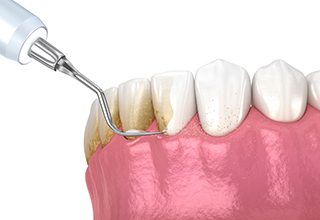Gum Disease Treatment – Owasso, OK
We Treat More Than Just Teeth

When it comes to your dental health, you’re probably primarily worried about your teeth, but you need to pay attention to your gums as well. Gum disease can easily develop without you realizing it, and if it isn’t treated in time, it could leave you with gaps in your smile. Dr. Voto and the rest of our team can screen for gum disease during one of your routine checkups, and they can take steps to treat it before it can grow more severe. Call us today if you would like to learn more about how gum disease treatment works at our office!
Why Choose Jayson D. Voto, DDS for Gum Disease Treatment?
- Thorough Scaling and Root Planing
- Customer-Service Oriented Office
- Trustworthy and Honest Dentist
What is Gum Disease?

Gum disease occurs when the soft tissues around your teeth suffer from an infection. The earliest stage of gum disease is called gingivitis; over time, it can eventually turn into a more serious condition known as periodontitis. Gingivitis can often be reversed by taking better care of the teeth and gums, but periodontitis cannot be fully cured and must be managed.
When left alone, periodontitis can lead to the loss of permanent teeth; it could also potentially raise your risk for heart attacks and other cardiovascular problems.
Symptoms of Gum Disease

Are your gums unusually red or swollen? Do you often find blood on your toothbrush or dental floss? Do your teeth appear to be longer? Has there been a change in your bite? Do any of your permanent teeth feel loose? All of these are potential warning signs of gum disease.
Of course, it’s important to keep in mind that gum disease sometimes doesn’t have any obvious symptoms at first. Your dentist can take a look at the state of your gums during your next checkup.
How Do We Treat Gum Disease?

Examining your mouth is the first step. We’ll take note of how severe your condition is and how much damage has already been done. Then we will work with you to create a treatment plan. It’s important that you understand the specifics of the care that you receive, so please don’t hesitate to speak up if you have any questions or concerns about the services we use to address gum disease.
Scaling & Root Planing

The plaque and tartar that cause gum disease often hide beneath the gumline, making them difficult to remove with a conventional dental cleaning. As such, we often recommend scaling and root planing for treating gum disease. Also called a deep cleaning, scaling and root planing involves using specialized tooths to eliminate infectious material from the teeth along and below the gumline and encourage the gum tissue to reintegrate with the dental structure. Here’s a brief guide to how this treatment works and who can benefit from it.
Do You Need Scaling & Root Planing?

The first stage of gum disease is inflammation called gingivitis, and it can usually be addressed by improving your oral hygiene habits. However, the advanced stage of gum disease is called periodontitis, and it causes permanent damage that must be managed with regular dental treatments. Your gum disease may require scaling and root planing if you notice symptoms such as:
- Swelling
- Bleeding
- Angry or dusky redness
- Chronic bad breath
- Gum recession
- Loose teeth
The Process of Scaling & Root Planing

Scaling and root planing typically requires two appointments and can be broken down into two parts. During the first appointment, Dr. Voto will use a device called a scaler to remove the plaque and tartar around and below the gumline and the pockets of the gums. During the second visit, he will use root planing to remove hardened bacterial deposits and smooth out the roots of your teeth to allow the gums to reattach more securely.
Aftercare Tips for Scaling & Root Planing

The process of scaling and root planing can be rather intensive, so the patient’s teeth and gums will usually need a few weeks to recover afterward. To reduce your discomfort and sensitivity and encourage thorough healing, stick to the following guidelines:
- Rinse your mouth with a solution of a quarter teaspoon of salt and eight ounces of warm water to reduce irritation and gently remove food debris from the teeth.
- Brush your teeth gently with a soft-bristled toothbrush while using circular, short strokes. Brushing too vigorously can worsen your discomfort.
- Stick to a soft diet for the first forty-eight hours after treatment.
- Avoid foods and beverages that are hot, spicy, or acidic.
- Abstain from alcohol and tobacco use for at least a few days after treatment.
- Refrain from intense physical activity for twenty-four hours after the procedure.
